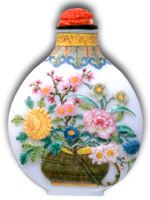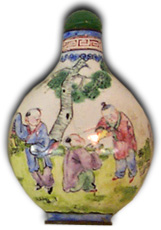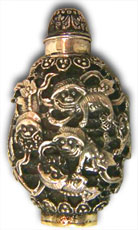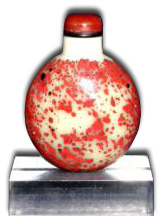While taking snuff may have fallen out of favor, snuff bottles continue to be treasured. Collectors can now go to eBay and see more than 400 snuff bottles. This rare enameled and carved Imperial snuff bottle sold for $134,500 on eBay


European Snuff Bottles
In Georgian and Regency times, snuff was a craze, a habit and a drug, and its containers today are very fashionable and attractive.
Snuff is powdered tobacco, which, in times gone by, was inhaled genteelly from a knuckle or thumbnail. Ready-ground snuff came in two main varieties: light, which had been matured in a hot sauce; and dark, to which medicinal or sweet-smelling flowers, salt and potash had been added.
Flavours of Snuff
A range of additives, used singly or in combination, produces interesting flavours. Ammonia, almonds, soda, sandalwood, vanilla and violet roots, for example, were just some of the substances that were added to ground tobacco as it matured. Different flavours appealed to different tastes; a sauce of aromatic oils of cedar, lavender and bergamot was a concoction particularly liked by women.
An important part of the social ritual was the box or bottle in which the snuff was contained. Plain wooden snuff boxes, made in large numbers, were used by many people. Fine snuff boxes, in attractive or precious materials, were the prized personal possessions of the rich and privileged. Adults of wealthy families often had several.
In Georgian society, a fine silver snuff box could be taken as the mark of a lady or gentleman of wealth and distinction. Colourful enamel snuff boxes were also something of a status symbol. Less expensive snuff boxes were made of ivory, tortoiseshell or papier mache’ with mother-of-pearl decoration. Superior wooden snuff boxes had silver or ivory inlay or decorative ink tracery; others took amusing shapes, from animals to shoes.
Snuffboxes, as objects of high fashion for both men and women, were frequently made in precious materials, ranging from gold and silver to enamel and porcelain. They were often highly ornate with painted scenes and gilding.
So many were produced that they can still be readily found in antiques shops and markets. Rare types appear at fine art auctions and can be bought from specialist dealers. Virtually no china or porcelain boxes were made in England; they came almost exclusively from the Continent. Enamelled snuff boxes were produced in England at Battersea, Birmingham and also Bilston. Some were made as souvenir boxes, while others were in the shape of birds, rabbits or other animals these last are likely to be expensive.
The best boxes were in silver or gold, but base metals, such as pewter, lead, brass and pinchbeck, were also used. Tortoiseshell was used from the 17th century onwards – it was light and easy to carry. Pressed horn was often used instead, while carved bone was used in place of ivory.
Papier mache’ was widely used for table boxes. Wooden snuff boxes were carved into shoes, skulls, bellows, frogs and even coffins.
Collectors can now go to eBay and see more than 400 snuff bottles
Chinese Snuff Boxes & Bottles
Chinese snuff bottles were brought back by traders from the Far East as souvenirs or gifts. Many were used for taking snuff but often they were displayed as exotic curios in a gentleman’s library. Porcelain bottles were made in the largest quantities in China.
They are wonderful things. If you like them, buy them. They can be pricey but are good looking if well-kept. Some still make excellent little containers. Others are purely decorative and make fine conversation pieces.


Chinese painted enamel snuff bottle, Qianlong period, c. 1736-95
A History of Snuff
To appreciate the Chinese snuff bottle as a collectible, one has to know something of the history of snuff. Early references to the invention of snuff are vague, although most believe that it began with the arrival of smoking tobacco in Japan during the late 16th century. Some scholars credit the Japanese with introducing snuff to China, where its use exceeded that of any other country in the Far East.
Originally introduced as a medicine, snuff was very popular among the Chinese aristocracy for the exhilarating feeling that it produced. By 1680, Imperial workshops were established in the Forbidden City in Beijing. Here craftsmen produced the most elaborate snuff bottles for the Chinese aristocracy. During the reign of the Qianlong emperor between 1736-1795, snuff bottle production reached its height in China.
Collectors can now go to eBay and see more than 400 snuff bottles
Collecting Snuff Bottles
Chinese snuff bottles are highly functional works of art. As a mixture of powdered tobacco, herbs and spices, snuff has a tendency to cake easily in humid environments. The dense humidity of the climate in the Far East led to the invention of 2 to 3 inch high containers fitted with a top. Fastened to the inside of the top is an interior ladle that ends with a tiny spoon, from which the snuff is inhaled through the nostril.
Chinese Snuff Bottles come in a variety of materials, and collectors will often focus on a certain medium or decorative subject matter. Porcelain is the most common medium, although there are overwhelming choices in jade, agate, glass, silver, ivory and lacquer.


Chinese deeply moulded silver snuff bottle with monkey motif
Dating snuff boxes is difficult unless the box is in hallmarked silver or gold. Experience is obviously the key, so take every opportunity to familiarize yourself with the subject. You will be able to date many examples by comparison with specimens in museums.
Collectors of old and valuable Chinese snuff bottles should be on their guard against modern imitations of Chinese inside-painted bottles and plain glass ones incised, carved or moulded in imitation of materials such as jade, coral or agate.
Check that what you are buying is in good condition. Bottles should be complete with their stoppers. Always check any hinges. Look out for cracks in wood, splits in silver, cracks in horn, bone and tortoiseshell, and cracks or chips in stone or glass Chinese snuff bottles.
Collectors can now go to eBay and see more than 400 snuff bottles
The Market for Snuff Bottles
The current Asian art market is enjoying the upswing of a strong economy in the United States. One of the strengths of the snuff bottle market lies in the fact that it has always been fueled by an international clientele of dedicated private collectors and trade. Not only are there important Asian buyers, but major players in Europe and America.
Prices for snuff bottles don’t fluctuate as much as other areas of the Asian art market due to the nature of the collectors. Dedicated private collectors of snuff bottles tend to be highly specialized and tend not to buy other Asian art. As a result, prices remain steady when other areas of the market are experiencing a low period.
At the very top of the market, Imperial snuff bottles are considered to be the holy grail of collecting. A bottle that is associated with Imperial craftsmanship can sell at auction for anywhere between $100,000 to $150,000. A recent example of an enameled and carved glass bottle sold for $134,000 against an estimate of $50-70,000.
The incredibly strong price for this bottle is due to a number of factors. First of all, the workmanship was very special, with extraordinary carving. The bottle also has a great provenance, having come from the collection of Alfred M. Landon, a Snuff Bottle collector and U.S. presidential candidate in the 1940’s. But most importantly, there was the guyuexuan (Ancient Moon Pavilion) mark on the base. This mark firmly attributes the bottle to an Imperial workshop during the period of 1750-1850.
Fortunately, there are many snuff bottles on the market that fall in the average price range of $1000 to $5000. Novice collectors can find decent enameled glass snuff bottles in the $400 to $500 range.
Chinese Snuff Bottles (Images of Asia) by Robert Kleiner
It is not unheard of to find snuff bottles in flea markets for considerably less, although forgeries are common. The biggest disappointment in today’s market is how finely crafted these fakes can be, and how easily they deceive.
During the past 10 years, the market has benefited from the publication of scholarly books that showcase the world’s most important collections. We recommend that new collectors first invest in reference materials. These publications sell in the $200-300 range and are also highly sought after among snuff bottle enthusiasts.


Chinese caramel glass snuff bottle with cinnabar splashes, attributed to Beijing, possibly Imperial, c. 18th century
Collectors can now go to eBay and see more than 400 snuff bottles that will be sold at an upcoming online auction. Estimates range from $400 to $10,000.
Within the rarified world of Asian art, snuff bottle collectors have always had the advantage of being able to choose from a wide variety of price level, quality, and medium. And while the practice of taking snuff may have fallen out of favor, the legacy of this old custom is alive and well for collectors of snuff bottles.
Related feature stories
What are Garnitures? Mantelpiece decorations, usually vases
Value of Collecting Chinese Porcelain. Chinese Dynasties
Why Collect Asian Art? What to collect
Japanese Pottery: Satsuma & Japanese Era Names (Nengo)
National Gallery of Victoria sets a new world record with House of Chanel purchase





